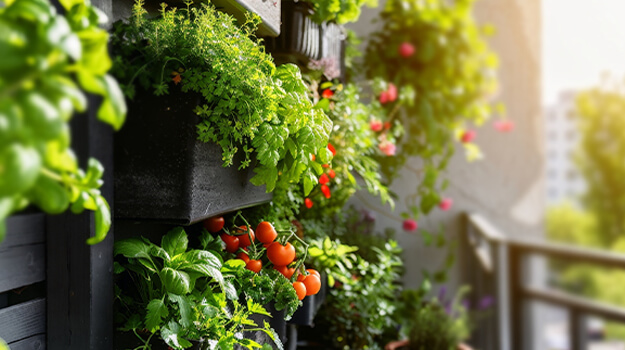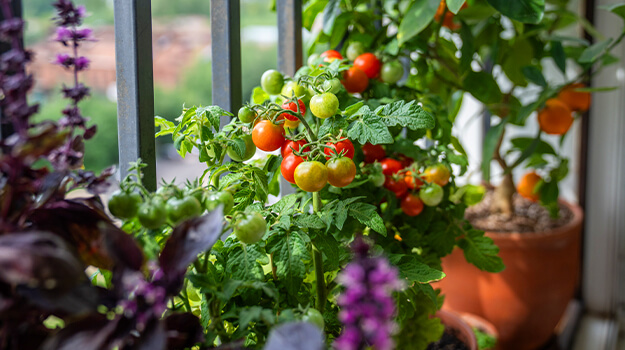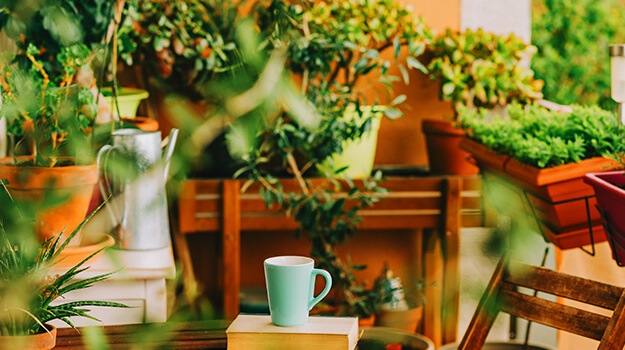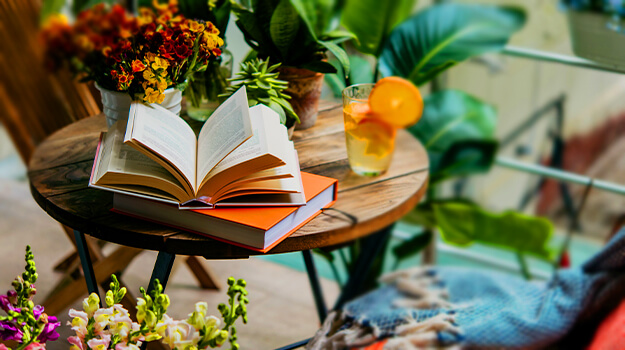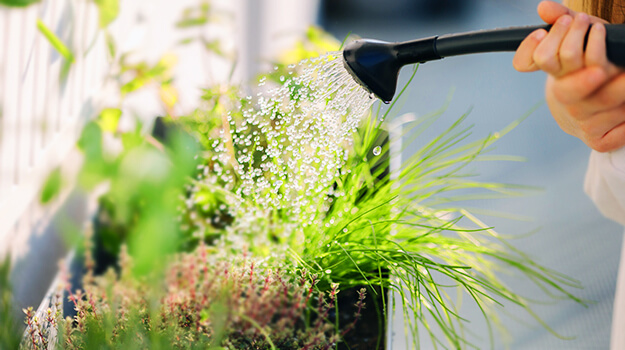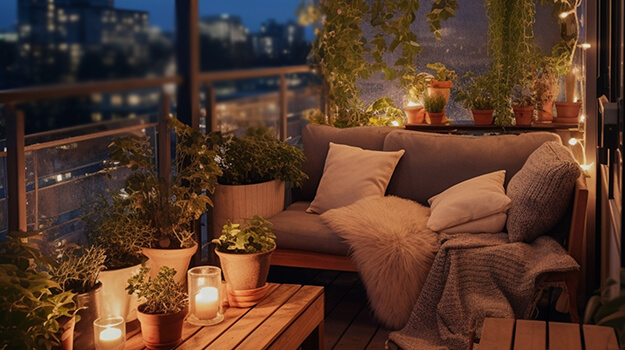If you live in an apartment or condominium, it is possible to transform a boring balcony into an extension of your indoor living space. Make it into a green oasis for your relaxation and enjoyment. With a little creativity, by adding plants, furniture and decor, you can connect with nature, reduce stress and add beauty to a small space. All the while providing yourself with fresh herbs, vegetables and flowers.
After interviewing balcony gardeners from across the country, one of the most frequent emotions we observed from them regarding balcony gardening was relaxation. When they came home from their daily work and travel stresses in the city, it seemed that watering, dead-heading and pruning plants would unwind them by connecting with nature. That, and a glass of wine.
Is your balcony garden-ready?
A couple of things need consideration.
Does your building have restrictions on what can go on it? Check before you start.
Can the balcony manage the extra weight? Multiple containers full of moist soil can add a fair bit of weight.
Neighbours below you. You need to be cognisant that your excess water and dirt doesn’t land on your downstairs neighbour’s balcony.
How is the sun exposure? The most critical factor to consider is how many hours of sunlight are available. You may have to plan for different plants depending on the hours of sun and adjust to shade plants in low-sun areas.
Can it get too hot? Sun reflecting off windows can intensify heat and concrete/brick walls can absorb and hold heat. This may be great for heat-loving plants, but you may have to adjust to what is planted or put up some sun screening.
Is it windy on your balcony? Intense winds are common on balconies, especially when there are many buildings around that can create a wind funnel. You may need to put up some type of windbreak.
Proximity of water. Balcony plants require plenty of water. You’ll need a big collapsable watering can or a retractable hose to your nearest tap inside.
Balcony gardening can be extremely rewarding for you and your family. You just need to be aware of any issues before you start.
You’ll bring in a touch of nature to your environment, create an opportunity to relax in an additional space, and give yourself the opportunity to enjoy gardening.
How do I turn my balcony into a garden?
Think of your balcony as an extension of your indoor living space. Choose textures, plants and colours to match your interior design. That will help make even the smallest balcony seem more expansive and welcoming.
You don’t need as much space if you take advantage of your walls, railings and ceiling. You could attach trellises, pots and shelves to walls, and use ladder plant stands and freestanding vertical garden stands. You could make use of your railings with railing planters, and the ceiling with hanging planters. You may want to investigate the various self-watering vertical garden kits available.
If your space is small, start small. You can eventually go to the effort and expense of a more elaborate garden, but a beginner should start with a few planters scattered around the edges of the balcony to get a sense of wind, sun, shade and the time and effort involved. Walk out a few times a day to see which way the wind blows, and how much sun each area is getting.
Balcony garden ideas for small spaces
- Vertical planters
- Planters and plant stands
- Hooks and hanging baskets
- Trellises and slatted walls
- Railing planters
3 tips for successful container gardening
Remember that small containers will dry out quickly. There are 3 rules of thumb regarding containers for balcony planters:
- Choose the best soil for your pots and planters. Use a quality soilless container potting mix, not garden soil. Its high porosity enables it to retain air and water, and to release water when required. Its stable structure is useful, especially for long-lasting plant cultures. Garden soil is usually heavy, has poor drainage, often contains weed seeds, and is terrible in a planter. Garden soil in the garden is excellent as it has a rich life of micro and macro-organisms. But not good in a container. To compensate for the loss of nutrients in a soilless mix, you should fertilize with a diluted liquid or soluble fertilizer every second watering.
- Prefer big containers. Get containers as big as possible as these do not dry out as fast and won’t tip over so easily on windy balconies. You could investigate the world of self-watering planters. These types hold water in a chamber underneath that has a wick system connected to the bottom of the potting mix, which keeps it moist longer. Self-watering containers come in plastic or fibreglass. Good to know since this makes them lighter and easier to carry up to your dwelling. Compare this to heavy terra cotta and clay planters.To be sure your vegetable plants have enough space to grow, consult our chart: The Best Vegetables to Grow in Containers | PRO-MIX Gardening
- Make sure your pots have drainage holes. Drainage holes are necessary in all containers to provide good drainage and not drown your plants. Best advice is to use a sealed tray underneath to keep overflow from dribbling all over your balcony floor.
What plants are best for a balcony?
You can plant pretty well anything that you like, as long as there is enough sunlight. Most plants need 5-6 hours of sunlight a day. The sky is the limit for your balcony garden: annual flowers, edible vegetables and herbs, perennials, bulbs, and even dwarf shrubs and trees.
Herbs are great balcony plants, as they do well in a container, are aromatic and can be picked all season long for cooking. Bedding plants offer you a wide variety of colours, growing habits, can be mixed in the same planter and are available for sun, sunshade and shady spots on the balcony.
Many garden centres supply already planted and established large planters filled with herbs or annual flowers, and may even deliver them. Instant balcony garden!
If you want to create beautiful potted arrangements perfect for your space, get all the information and inspiration here: How to succeed with your potted arrangements.
There are a lot of common vegetables that can be planted from seed, from transplants or bulb sets: peas, beans, lettuces, radishes, kohlrabi, Swiss chard, onions, pak choi, short-root carrots, dwarf bush cucumbers, spinach, compact tomatoes, peppers, cauliflower, broccoli and cabbage.
An easy fruit: strawberries do well in a dedicated strawberry planter placed in a sunshade area.
You can look at having perennial plants on your balcony, but consider them as annuals. If you want them to overwinter, choose hardier plants (two hardiness zones colder). Then you have a chance to see them regrow next spring. Many balcony gardeners like to plant spring bulbs for their summer flowers. After flowering, some bulbs and tubers can be removed, dried and stored in a dry, dark spot for the winter and replanted the following spring. For example: canna, caladium, dahlia, gladiolus.
Cannas can also spend all winter inside, beside your tropical plants, and even bloom! For more information: Summer bulbs: how to grow them indoors.
Why not bring your larger houseplants out to spend the summer outdoors? Just be aware that you’ll need to acclimate them in low-sun areas at first. Some will enjoy full sun, but many will do better in sunshade spots.
If you don’t want to get rid of all of your plants after summer, we have some suggestions for you. Learn how to bring them inside and care for them during winter in this article: Bringing outdoor plants indoors for the winter
What are the best plants to grow on a balcony or terrace?
- Climbing vines and flowers
- Succulents
- Dwarf fruit trees, olive trees or tropical hibiscus trees
- Vegetable plants
- Herb plants
- Potted perennials and annuals
What are the best low-maintenance outdoor balcony plants?
- Purple fountain grass (Pennisetum purpureum)
- Rosemary (Salvia rosmarinus)
- Rose (Rosa)
- Fuchsia
- Garden sage (Salvia officinalis)
- Winter jasmine (Jasminum polyanthum)
- Common thyme (Thymus vulgaris)
- Japanese maple (Acer japonicum)
Facing north, south, east, west: what can you grow in a balcony garden?
Does your balcony face south and get direct sunlight all day? Pots in full sun all day can bake out there. Cacti, succulents and many flowers and vegetables, if kept well watered, will do well. Plants like tomatoes, peppers, lavender, oregano and rosemary are sun lovers. We have even seen sweet corn on some balconies.
Here are some suggestions for the best tomato plants to grow on your balcony: 10 tomatoes to grow on your balcony
Here are some sun-hardy plants to consider: Mexican fleabane, lamb’s ear, cistus, geranium, lavender, lily of the Nile, rosemary, thyme, sage, wallflower, hens and chicks, echeveria, pheasant’s tail grass, Mexican feather grass, aster, ice plant, verbena and coneflower.
You can find more suggestions here: Creating drought-tolerant gardens
A west or east-facing balcony will work well for most plants, as long as they get 5-6 hours a day of direct sunlight.
If your balcony faces north or is shaded by other buildings for most of the day, search for shade-tolerant plants like ferns, hostas, begonias, nicotiana, impatiens, spinach, lettuces, parsley and chard.
How to water plants on a balcony?
Gardening on a balcony offers several benefits, but there are also challenges. One of them is watering. Here are 8 tips to properly water your container plants.
- Choose the right soil. Choose a mix adapted to container growing and that offers good drainage while limiting evaporation. Those qualities can save your plants should they be under or overwatered.
- Choose the right kind of pot . Consider its size (smaller pots contain less water), the presence of drainage holes to evacuate excess water, but also the material and colour of the pot (black pots can get hot in the sun, and this can affect the roots of your plants). This article will help you choose: The Best Vegetables to Grow in Containers | PRO-MIX Gardening
- Check the humidity level before watering. In hot or very dry weather, it may be necessary to water more than once per day!
- Water thoroughly. Water deeply, until it comes out of the drainage holes. If you don’t see any water running out, you haven’t watered enough. Dispose of the excess water in the saucers after watering or after the rain.
- Ideally, water in the morning. Watering in the morning reduces evaporation caused by the wind and heat and allows wet leaves to dry before nightfall. If it’s not possible or if your plants are thirsty during the day, water when you can.
- Water the soil, not the leaves. Getting the leaves moist can increase the risk of fungal disease and could burn the foliage.
- Don’t wait for the rain!
- Don’t let the soil dry out completely. If that happens, here are two ways to rehydrate it. Immerse small pots in a bigger container or sink until it stops bubbling. For large containers that are more difficult to move, poke holes in the soil using a pencil and let water trickle down, making sure it is absorbed. Repeat until the soil is thoroughly moist.
Balcony decorating ideas: small space with big style
The balcony must have space for you: small, comfortable chairs and table set, string lights, candle lanterns, railing lights, bubbler fountain, privacy screen, outdoor rug, wall decorations, chimes, colours… Use your imagination!
If your balcony is big enough, bring out comfy, cushioned chairs. Every balcony is unique, so the urban gardening design that you decide on should be tailored to your situation. The goal is to create an outdoor space that you actually want to spend time in.
TIPS:
- Since you will only need some hand tools, you can get a basket or tool bag to store them, or a small potting table with shelves or drawers.
- Before winter: pull out annuals, and if available for your building, put them in the compost bin. You can leave what’s left of the old potting mix in the containers, and next spring stir it up, mix in some organic fertilizer and top the planters up with fresh potting mix.
Get bright ideas to transform your balcony in this article: Lighting in the garden: 10 bright ideas to extend the summer days



